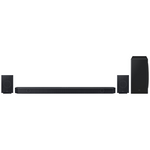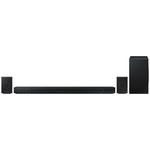
TV and audio is a constantly evolving area of technology, consistently adapting and implementing new technologies. From the outside it can look and sound like a convoluted maelstrom of jargon and buzzwords but choosing a TV doesn’t have to be complicated.
The purpose of this buying guide is to serve as an entryway; a portal to the wide world of TV and audio, breaking down barriers and assisting in finding the best tech for your home. With the universe of 4K UHD TV at your fingertips, encompassing TVs, Blu-ray players, and streamed content, there has never been a better time to dive into the world of TVs.
What is TV Resolution?
TV Resolution refers to the number of pixels that make up an image, with more pixels allowing for the presentation of more detailed images. This combines with improved contrast ratios, bold colours, and smarter image processing technologies, to create incredible images.
Why do extra pixels matter?
The more pixels, the crisper and more detailed your images appear. This is due to more pixels working in tandem to create additional details across a similar area. While there are other important aspects to consider (we cover these in the next section), the difference in picture quality is very noticeable.
Note that content must be in 4K format - many streaming services such as Netflix, Amazon, iTunes and Stan are offering more and more 4K shows and movies. You can also experience 4K quality with a 4K-compatible Blu-Ray Player and Blu-Ray discs.
What is 4K?
You may have heard the terms high definition and full high definition before reading this, and 4K is basically the next step up in screen resolution. Also known as UltraHD, 4K fills your screen with over eight million pixels.
But what does that mean?
More pixels filling your screen leads to greater detail and colour saturated images. Colours will appear brighter, and any images that grace your screen will present themselves with unsurpassed detail and vibrancy. To put this into perspective, a 4K TV will provide you with four times the detail of a standard HD model.
What is 8K?
Let’s take it up a notch with the entrance of 8K TVs. Providing greater image clarity, especially on larger screens, 8K TVs make use of 33 million pixels; four times as many as 4K screens. A caveat to the arrival of 8K is that there is a lack of content designed solely for 8K screens. However, any non-8K content that is viewed on these screens will be bolstered by the magic of upscaling, which enhances image quality marvellously.
TV Resolution: | Ideal For: | Cons: |
|---|---|---|
Ultra HD | Blockbuster movies, sports, gaming, and other dynamic content with the best picture possible Future investment in TV technology Older Full HD content can be 'upscaled' into Ultra HD | Full HD has a lot more content (as it's been around a lot longer) |
Full HD | Watching Blu-Ray discs and all mainstream TV programming at its highest current level. If you're not overly fussed about having the latest and greatest in picture quality (and most affordable) Small-space living (such as caravans and other portable homes (Ultra HD hasn't gotten this small yet). | Previous screen standard (will be phased out as Ultra HD is developed) |
What is a Smart TV?
What is a Smart TV?
Of course, with all these amazing TV screens and image technologies, you're going to want great content to match. Many TVs feature smart features and Wi-Fi capability to open up a larger world of home entertainment. Smart TVs can offer built-in programs including Netflix, Spotify, Android TV, Google Assistant, Chromecast, and more, which pairs quite well with 4K Ultra HD screens. Of course, smart TV functionality isn't just relegated to the 4K UHD models, with it being more and more common with Full HD, HD, and 8K TVs. Some smart TVs can even be operated through Google or Alexa-enabled smart speakers, in some cases your TV can be integrated within your existing or fledgling smart home.
What is 4K Upscaling?
While you may have a 4K TV, not all content is created specifically for 4K viewing, which could hamper the quality a little bit. But just hold on to your hats ladies and gentleman, because the visual quality is enhanced through a process known as ‘upscaling’. Basically, upscaling takes non-4K content and improves it, making it look more vibrant than it would on a non-4K TV.
However, there are an abundance of Blu-ray discs and even certain Netflix shows that have been mastered in 4K, with the list growing ever-longer. These, of course, are a pinnacle of viewing on your 4K devices.
Home Movie Viewing: What is 4K Blu-Ray?
Aside from being a rather nice rhyme, 4K Blu-ray is the ultimate way to view 4K movies at home. It’s a quintessential pairing, like wine and cheese or showers and singing; they just work together. But if you have an existing standard Blu-ray collection, you can still watch your favourites, and as an added bonus the player will upscale them close to 4K.
What is the Best TV Display Technology?
If you have spent any time researching TVs, you will undoubtedly have come across the acronyms OLED and QLED, which refer to how images are displayed. To prevent any confusion that may arise, QLED, OLED and LED all refer to how the screen is lit up and images displayed, while HD,4K and 8K refer to the resolution of the image itself.
What is a QLED TV?
A name trademarked by Samsung, QLED or ‘Quantum dot Light Emitting Diodes’, are special particles that absorb and redistribute light supplied by an LED panel as a much brighter and purer light source. Quantum Dots, which are what QLED TV screens are composed of, are luminous crystals that glow when light is shined on them.
Essentially, this screen/panel/film is saturated with Quantum Dots that, when exposed to a source of light from the LED panel, delivers colour with increased brightness, accuracy and saturation.
What is OLED TV?
Standing for ‘Organic Light Emitting Diode’, OLED TV screens utilise an organic carbon-based material to light up areas of the screen. It’s thanks to this technology that OLED screens can be made impressively flexible and thin.
What is an LED TV?
Starting with the basics, LED stands for ‘Light Emitting Diode’ which consists of small semi-conducting bulbs that glow when exposed to an electrical current. These particular diodes provide wonderful contrast and are quite efficient power users.
What is the Difference Between OLED and LED?
The main difference between LED and OLED screen displays is in how they present their images. LED uses LCD technology and an LED backlight, while OLED screens don’t require a backlight.
OLED displays are composed of an organic material which glows when activated by an electrical current. Each pixel is its own independent light source, which allows for utmost control of the display. More importantly, each pixel can turn off completely, presenting absolute blacks and incredible contrast.
Is QLED or OLED Better?
As you may have guessed, QLED and OLED are two different TV display technologies, which each have their own pros and cons. QLED is an LCD TV which utilises quantum dots while an OLED TV isn’t an LCD TV at all.
As to which are better, QLED TVs generally tend to be brighter than their OLED and LED counterparts, making them great for brighter rooms. OLED TVs, on the other hand, deliver superb contrast due to their ability to achieve absolute black.
OLED TVs also tend to be more expensive than their QLED contemporaries.
TV Technology (how the screen is lit) | Ideal for: | Cons | |
|---|---|---|---|
QLED (Quantum dot Light-Emitting Diode) A newer type of energy-efficient LED/LCD screen. Generally cheaper than OLED. | Bright, vibrant colour - especially useful during the day and in brighter rooms, as the brighter screen will overcome the ambient light pollution. | Not as thin as OLED (as QLED requires space for its backlight) Technology relies on older LCD technology | |
OLED (Organic Light-Emitting Diode) OLED screens light up each pixel individually. The result is a very crisp, detailed image with very little image blur and better viewing angles around the room. | Rich, 'natural' colour and brightness - good for watching TV in darker environments. Slim, lightweight display | Only LG offer the wider range of OLEDs (LG also supplies panels to Panasonic, HiSense and Sony) Not currently available below 55" size | |
Most affordable high-quality option - a good choice for all lighting | Heavier and thicker than OLED/QLED |
What are the types of HDMI?
You are most likely already familiar with the humble HDMI cable, the nifty device allowing you to connect DVD players, game consoles, and more, to your TV. A HDMI cable is designed to transmit either uncompressed video data or compressed/uncompressed digital audio data, to compatible devices. In a nutshell, a HDMI cable can transmit audio or visual information between devices. As technology has improved, HDMI has also experienced some improvements, in the form of eARC and ARC HDMI.
What is HDMI ARC?
‘ARC’ stands for ‘Audio Return Channel’ and is a common feature on TVs, soundbars, and receivers and allows for two-way communication between devices using a single HDMI connection. This can reduce the cable clutter you may have hidden behind your TV cabinet as well as simplify your setup.
But what can you do with HDMI ARC?
For example, if you have a soundbar or audio setup, you can connect your TV to your soundbar using a HDMI ARC port. This cable then transmits audio information for every device that connects to your TV, such as game consoles.
This frees you from the necessity of an audio receiver, particularly if you use external audio devices or other devices.
What is HDMI eARC?
HDMI eARC is an improved version of HDMI ARC, designed to provide the best possible audio resolution from your TV. The name is testament to this, with ‘eARC’ standing for ‘enhanced Audio Return Channel’. With eARC, full-resolution audio signals can be passed between your TV audio systems. This includes 3D surround sound formats, such as Dolby Atmos and DTS:X
Using eARC, your HDMI devices can be plugged directly into your TV, which will then transfer uncompressed, high-quality audio to a soundbar or receiver, from the eARC port.
What is HDR?
When it comes to choosing your next TV, resolution is literally only half the picture; you need high dynamic range (HDR) to make images truly pop. HDR enables TVs to produce a higher contrast ratio, a larger volume of colours and brighter picture, which really makes your on-screen content come to life.
To truly make the most of this, you have to watch content that is already in HDR, and with streaming sites such as Netflix and Amazon Prime at the helm, it is becoming more readily available. To get a truly marvellous HDR experience, you can watch 4K Blu-rays, but you will need a compatible 4K Blu-ray player.
Let’s break down the different types of HDR which you may encounter.
What is HDR10?
The standard of all HDR content. If a TV supports HDR playback, it will support HDR10, likewise, if a movie or TV show says it is in HDR, it’s in HDR10.
Do You Need HDR10+?
One of the newer HDR formats, HDR10+ adds in the use of dynamic metadata. This means that each and every video frame has its own brightness, contrast and colour level configurations. As a result, image quality is drastically boosted when compared to HDR10.
What is Dolby Vision?
Requiring specific hardware to play content in Dolby Vision, any content that is displayed will be as close to the source material as possible. In terms of HDR formats, Dolby Vision has been around for a little longer, so there is more available content that will support it.
HDR10 | HDR10+ | Dolby Vision | |
|---|---|---|---|
Colour Depth | 10 bit |
10 bit | 12 bit |
Metadata | Static | Dynamic | Dynamic |
Supporting Brands | All | Samsung, Panasonic, TCL | LG, Sony, Panasonic, Hisense |
Supporting Studios | All | Amazon, Warner and Fox Studios | Netflix, Sony, Universal, Paramount, Lionsgate |
What are Refresh Rates and Response Rates?
What are Refresh Rates?
Put simply, refresh rates are how often the on-screen image is changed or refreshed, to provide a seamless moving picture. While it may seem overly-technical, the refresh rate of your TV is an important factor to consider. This is particularly paramount if you’re an individual who likes watching fast-moving content, such as action movies or sport.
Refresh rates are measured in hertz (Hz) per second, so if a TV has a 60Hz refresh rate, a brand new image is being displayed 60 times per second. This is doubled if a TV has a refresh rate of 120Hz, a new image being displayed 120 times per second.
Is a Higher Refresh Rate Better?
In a nutshell, a higher refresh rate means that images you see will be clearer and smoother than images displayed with a lower refresh rate. If you have ever seen an older projector playing a black and white movie, the jumpy flow of the picture is the result of a low refresh rate. A high-refresh-rate serves to drastically reduce image blurriness (motion blur), providing an enjoyable viewing experience.
What are Response Rates?
Not to be confused with refresh rates, the response rate measures how long it takes between an input signal being received, to the displaying of an image on the screen. Take a game console for example; game information is being sent from the console to the TV, and the response rate determines how fast that information is displayed on-screen. Therefore a lower response rate is better for gamers, especially in competitive games.
TVs that have a dedicated Game Mode can dramatically improve their response rate by removing all internal processing, such as upscaling and noise reduction, which is not needed for modern game consoles as all of that processing is done in the console before the signal is sent to the TV.
But the response rate isn’t only important for gamers. If you have a dedicated receiver or soundbar for your home theatre system, a TV with a high response rate can lead to your audio and video signals going out of sync. This can lead to dialogue not matching up to the on-screen images, which can be quite irritating.
What Size TV Should I Buy For My Room?
What's the best size TV for my room?
With TVs spanning a wide range of sizes, choosing the optimal one can seem like an impossible task. To get slightly technical, the distance between the TV and where you would be viewing should be 3 x the diagonal size of the TV (your answer is in cm's).
This is because it is recommended that your TV take up at least 40% of your field of vision, helping to immerse you in your content. Since the sizes are often in inches, this could get a bit confusing, but our resident AV expert, Adam, has created a nifty guide to assist you. If you are unsure if a particular size would be right for your bedroom, living room, or rumpus room, the best policy is to go a size bigger - be sure to check out our TV Size and Dimensions Guide for more information.
But at the end of the day, the TV screen size comes down to personal preference, and to that end, the below table is just a guide to help you get started. So without further ado, let’s get to the sizing.
Screen Size (inch) |
Recommended Viewing Distance (cm) |
|---|---|
32 | 95 |
40 | 120 |
43 | 130 |
50 | 150 |
55 | 165 |
60 | 180 |
65 | 195 |
70 | 210 |
75 | 225 |
77 | 230 |
82 | 245 |
85 | 255 |
88 | 265 |
98 | 295 |
Wall-Mounting your TV
How high do you mount a TV?
When you’re wall mounting a TV, it’s important to make sure that you’re not mounting too high or too low. You don’t want to be craning your neck at any angle to watch the TV. Looking directly forward, your eyes should land dead centre in the middle of the screen.
Thankfully, many TV manufacturers now design their TVs with clear or nondescript cables, which makes setting your TV up much more attractive.
Types of wall mounts
TV wall brackets come in a variety of configurations, depending on the weight of your TV and how you interact with it. You'll generally need to purchase these separately. We've listed the range below to give you an idea of how your TV will look.
Audio and Home Theatre
As TVs become thinner, default sound quality has generally remained average.
Pairing your TV up with a quality soundbar, Hi-Fi system, or full surround-sound system is becoming more and more popular. Most TVs out of the box sound very basic, so it's worthwhile investing in a decent audio option to support your beautiful TV visuals.
If you need a little more help choosing the best audio to complement your setup, read through our Home Theatre Buying Guide.
Pros | Cons | Ideal For: | |
|---|---|---|---|
Most affordable and very simple to set up (only 1-2 pieces of equipment) Much better sound than default TV speaker Minimal design fits neatly and stylishly under your TV (including wireless options) | Not as powerful as surround-sound (although 2-piece soundbar packs are available with a separate bass subwoofer) Lacks the power to fill larger rooms (sound only projects from one general direction) | Smaller rooms Good quality audio without the expense & set up required for larger home theatre Renters and anyone looking for a compact, minimal speaker | |
Creates an immersive cinematic experience in your home (particularly as you increase the amount of channels, eg. 3.1, 5.1, 7.1) Fuller, broader range of sound | Takes more time to set up (and requires some general knowledge of TV connections) More expensive | Any room size If you're seeking a robust, cinematic audio experience to go with your brand new TV |




How Much Does Installation Cost?
Our Winning Services team can professionally install your new TV and remove and recycle your old unit.
We offer two types of TV installation: cabinet installation and wall-mount installation.
The biggest benefit of organising installation is that our installers deliver and install the TV in one smooth motion, ensuring you only have to be at home once.
To find out more and to book your installation, please call us on 1300 000 500.
Cabinet Installation
- Our Cabinet Installation includes:
• Delivery, unpacking and assembly of your TV.
• Connection of existing devices and existing power & aerial outlets to the new TV.
• Tuning free to air channels.
• Testing of TV and a general explanation of how to use your new TV.
• Removal of all rubbish and old TV if required.
Wall Mount Installation
- Our Wall Mount Installation includes:
• Delivery, unpacking and assembly of your TV.
• Mounting of TV to wall (wall bracket must be purchased separately, unless specifically included with TV).
• Connection of existing devices and existing power & aerial outlets to new TV.
• Tuning free to air channels.
• Testing of TV and a general explanation of how to use your new TV.
• Removal of all rubbish and old TV if required.
- Please note: TV installations are not available in all locations. Please call us on 1300 000 500 if you'd like more information.
When the Price is Right
With the cost of living always on the rise, being budget conscious is more important than ever. Thankfully when it comes to home appliances, like our TV range, you can always find one that suits your needs and won't break your bank. To make things as easy as possible, we've already put together all of our budget friendly models in one easy click. Remember, cheap doesn't mean bad - it just means you get the items you are after, at a great deal!
SHOP CHEAP TVS
Any questions? We're here to help!
Hi, I'm Adam, the TV and Home Audio product expert at Appliances Online. If you have any questions on TVs or home audio, or just need tips on how to get the best out of your TV experience, please don't hesitate to reach out to me or the team here at Appliances Online on 1300 000 500.
Happy viewing!

![Samsung 55 Inch The Frame QLED 4K Smart TV QA55LS03DAWXXY [2024] hero image](/ak/9/d/6/9/9d69bdb75bda5bffc0bace62e43c0019c5359fa5_GQ65LS03DAFXZA_003_Front3_Black-widget.png)

![Samsung 55 Inch DU7700 Crystal UHD 4K Smart TV UA55DU7700WXXY [2024] hero image](/ak/f/e/3/e/fe3ee4e717fe5b3dc8c3a6ee823564a38830d34c_UN43DU7000FXZA_006_Front2_Titan_Gray_Global_No.1_18_years.png-widget.png)




![Samsung 55 Inch Q60D QLED 4K Smart TV QA55Q60DAWXXY [2024] hero image](/ak/c/d/a/d/cdada74e6556cf554e0425e29098620fea162b8c_QA55Q60DAKXXS_006_Front2_Black_Global_No.1_18_years.png-widget.png)


























